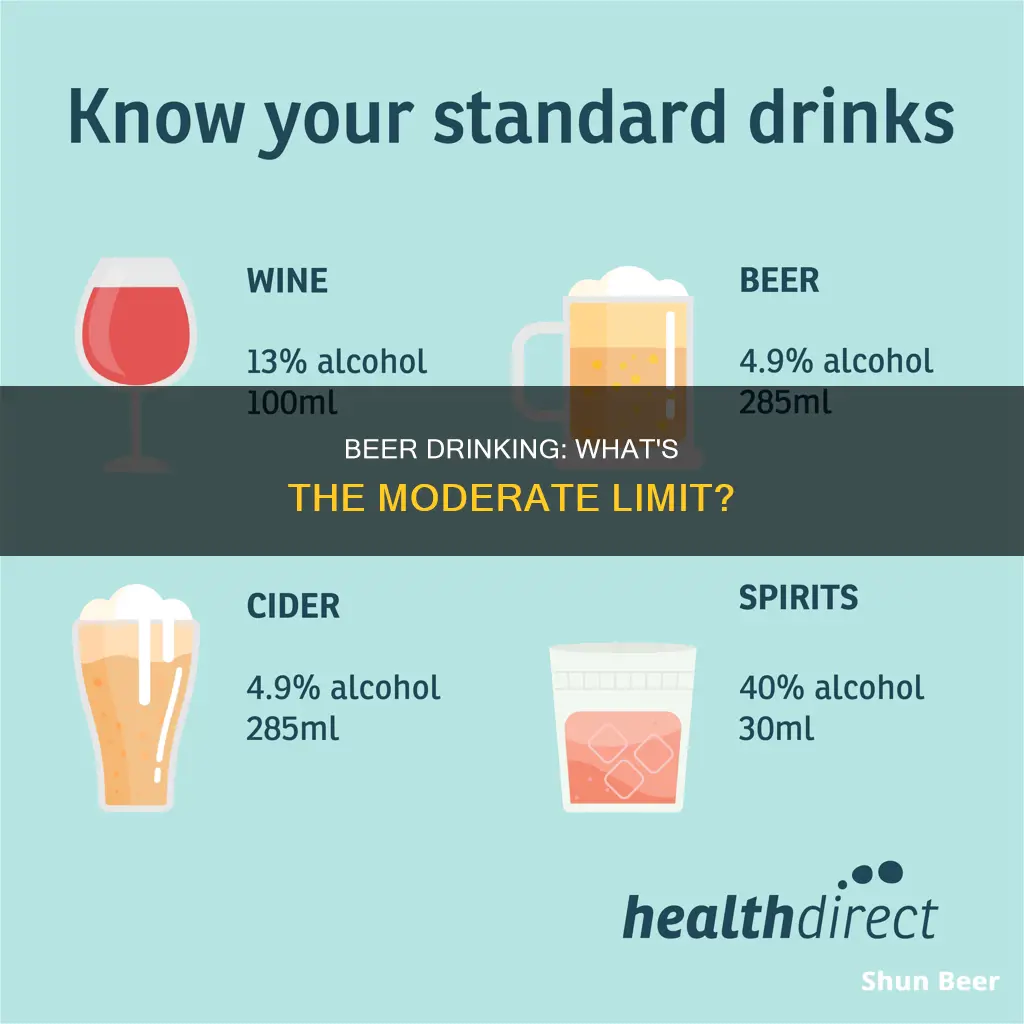
Moderate drinking is a topic of ongoing research and public interest. While the consensus is that excessive alcohol consumption is harmful to health, the definition of moderate drinking and its potential benefits or drawbacks are less clear-cut. The National Institute on Alcohol Abuse and Alcoholism (NIAAA) defines moderate drinking as up to two alcoholic drinks per day for men and one drink per day for women. However, other sources suggest that moderate drinking constitutes no more than 3-4 standard drinks per drinking episode, with a weekly limit of 9 drinks for women and 12-14 for men. This discrepancy highlights the need for further research and public awareness about safe drinking guidelines.
| Characteristics | Values |
|---|---|
| Definition of moderate drinking | No more than 3-4 standard drinks per drinking episode and a total of no more than 9 drinks per week for women and 12-14 for men |
| Standard drink | 12 oz (355 ml) beer with 5% alcohol |
| 5 oz (150 ml) glass of wine (12.5% alcohol) | |
| 1.5 oz (45 ml) of 80-proof liquor (40% alcohol) | |
| US guidelines | 2 drinks per day for men |
| 1 drink per day for women |
What You'll Learn

What is a standard drink?
In the United States, a "standard drink" is defined as any beverage containing 0.6 fluid ounces or 14 grams of pure alcohol. This is also known as an alcoholic drink equivalent. This amount of alcohol can be found in 12 fluid ounces of regular beer, 5 fluid ounces of table wine, or 1.5 fluid ounces of distilled spirits.
It is important to note that the percentage of pure alcohol, or alcohol by volume (ABV), varies within and across beverage types. For example, many light beers have almost as much alcohol as regular beer – about 85%. Regular beer typically has an ABV of 5%, while some light beers have an ABV of 4.2%. Therefore, it is important to know how much alcohol your drink contains, rather than focusing on the type of drink or the ounces of liquor.
Standard drink sizes vary across countries and regions. In the United States, a standard drink of beer (5% ABV) is 12 fluid ounces, a standard drink of wine (12% ABV) is 5 fluid ounces, and a standard drink of spirits (40% ABV or 80 proof) is 1.5 fluid ounces.
Beer and Mangoes: A Safe Combination?
You may want to see also

How much is too much?
Drinking alcohol in moderation is generally considered to be safe and may even have some health benefits. However, it is important to understand that excessive alcohol consumption can lead to serious health issues and increase the risk of certain diseases. So, how much is too much?
The definition of moderate drinking is typically defined as up to two alcoholic drinks per day for men and one alcoholic drink per day for women. A standard drink is typically defined as 12 fluid ounces (fl oz) of regular beer with 5% alcohol, 5 fl oz of table wine with 12% alcohol, or 1.5 fl oz of distilled spirits such as gin or vodka. It's important to note that the alcohol content of drinks can vary, so it's always good to check the labels.
While moderate drinking may provide some health benefits, such as a reduced risk of heart attack and stroke, it is important to understand that excessive alcohol consumption can lead to serious health issues. According to a recent study, consuming more than seven glasses of wine or beer per week was associated with a shorter life. Additionally, drinking in moderation may raise your risk of certain types of cancer, such as breast cancer, even at low levels of consumption.
It's also important to consider that drinking alcohol can affect people differently. For example, women are generally more susceptible to the effects of alcohol due to having lower body weight, lower levels of alcohol-breaking-down chemicals in the liver, and hormonal factors. As a result, women are advised to consume less alcohol than men to stay within the limits of moderate drinking.
Furthermore, certain individuals should avoid alcohol completely, including those under the age of 21, those who are pregnant or planning to become pregnant, and those with certain health conditions or taking specific medications.
In conclusion, while moderate drinking may be considered safe for some, it is important to understand that excessive alcohol consumption can lead to serious health issues. It is always advisable to consult with a healthcare professional to understand your personal limits and to ensure that your alcohol consumption does not put you at risk. Remember, drinking less is always better for your health than drinking more.
Beer and Blood in Stool: What's the Connection?
You may want to see also

Health risks of drinking too much
Drinking too much beer can have several negative consequences for your health. Firstly, beer contains empty calories, which can contribute to weight gain and obesity, leading to various health issues. Excessive beer consumption can also increase the risk of heart disease, liver disease, and alcohol dependency. Additionally, drinking too much beer can cause immediate health effects, such as trouble controlling emotions, violent behaviour, and alcohol poisoning.
The risks associated with excessive beer consumption are not limited to physical health. It can also negatively impact your mental health, making existing conditions worse and increasing the risk of self-harm and suicide. Furthermore, drinking too much beer can lead to risky behaviours, including unprotected sex or involvement in violent situations, which can have serious consequences.
According to the National Institute on Alcohol Abuse and Alcoholism (NIAAA), moderate drinking is defined as up to two alcoholic drinks per day for men and one drink per day for women. A drink is typically defined as 12 fluid ounces of regular beer with an alcohol content of around 5%. Binge drinking and alcohol abuse are associated with more immediate health problems, and the potential benefits of moderate drinking are outweighed by the negative consequences of excessive consumption.
Excessive alcohol consumption over a long period can lead to liver disease and other fatal conditions. The American Cancer Society has linked alcohol consumption to an increased risk of cancers, including mouth, throat, breast, colon, rectal, liver, oesophageal, and pancreatic cancers. It is important to note that there is no safe drinking level, and the less alcohol consumed, the lower the health risks.
Cowboys and Beer: A Historical Perspective
You may want to see also

Who shouldn't drink at all?
Moderate drinking is defined by the National Institute on Alcohol Abuse & Alcoholism (NIAAA) as up to two alcoholic drinks for men and one for women in a single day. However, drinking alcohol, even in moderate amounts, is not safe for everyone. Here are some groups of people who should avoid drinking alcohol altogether:
Pregnant Women
Pregnant women or those who may become pregnant should refrain from consuming alcohol. Alcohol consumption during pregnancy can increase the risk of pregnancy loss and cause growth and developmental problems for the child. Even before conception, alcohol can negatively impact fertility in both men and women.
Individuals on Certain Medications
Drinking alcohol while taking certain medications can lead to serious side effects and adverse health consequences. This includes prescription or over-the-counter medications such as sedatives, painkillers, and antibiotics. Alcohol, as a central nervous system depressant, can amplify the effects of sedatives, leading to extreme sleepiness, disorientation, and even seizures or breathing problems. Combining alcohol with common painkillers like ibuprofen or acetaminophen can cause stomach bleeding and liver damage. Additionally, drinking while on antibiotics can cause reactions ranging from liver damage to high blood pressure.
Individuals with Specific Medical Conditions
People with certain medical conditions that can be exacerbated by alcohol consumption should avoid drinking. This includes individuals with cirrhosis or other medical issues that alcohol may worsen.
Adolescents and Minors
Alcohol consumption by children and adolescents should be strictly avoided.
Recovering Alcoholics or Those Unable to Control Consumption
Individuals who have difficulty limiting their alcohol intake or are recovering from alcohol use disorder (AUD) should not drink at all.
Individuals Planning to Drive or Operate Machinery
Those who plan to drive a vehicle or operate machinery should refrain from consuming alcohol. Alcohol impairs reaction time, coordination, concentration, vision, and judgment, making it dangerous to engage in activities requiring skill and alertness.
In summary, while moderate drinking may be considered acceptable for some, it is important to recognize that alcohol consumption can be detrimental in certain circumstances and for specific individuals. It is always advisable to consult with a healthcare professional if you have any concerns or questions about alcohol consumption.
Drinking Beer in Public: Texas Law Explained
You may want to see also

How to cut back on drinking
According to health experts, moderate drinking is defined as up to two alcoholic drinks for men and one for women in a single day. However, it's important to note that even moderate drinking can lead to health problems in the long run.
Set Realistic Goals
Write down your maximum daily and weekly drink limits and stick to them. This will help you set clear boundaries and reduce the harm caused by alcohol. Remember, any change, no matter how small, can positively impact your health.
Record Your Drink Intake
Keep track of how many drinks you have. You can use a drink tracker card in your wallet or simply record it on your phone. This will help you stay accountable and aware of your consumption. Make sure you accurately measure your drinks and know what constitutes a standard drink.
Pace Yourself
Slow down your drinking by sipping slowly or limiting yourself to one drink per hour. Drinking too quickly, especially at the beginning of the night, increases the risk of alcohol misuse and dependence. Try using drink spacers by alternating alcoholic beverages with non-alcoholic ones like water, juice, or soda.
Avoid Triggers
Identify and avoid situations, people, or activities that trigger your urge to drink. If drinking has become a regular part of your life, substitute it with other activities like hobbies, exercise, or spending time with family and friends. Find something enjoyable to occupy your time and distract yourself from drinking.
Learn to Say No
You will likely find yourself in situations where you're offered a drink. Learn to politely but firmly decline, saying "No, thank you." Practice what you'll say ahead of time so you're prepared and confident in your refusal.
Seek Medical Support
Consider consulting a healthcare professional about medication options, such as naltrexone, which can reduce the pleasure associated with drinking and make it easier to stop. Additionally, support groups like Moderation Management can provide valuable guidance and community as you work towards cutting back.
Remember, the key to successfully cutting down is finding what works best for you. Even if you struggle at first, don't give up. You can always seek additional help or consider quitting drinking altogether if needed. Your health and well-being are worth the effort!
Beer Consumption: Weekly Safe Limits Explored
You may want to see also
Frequently asked questions
Moderate drinking is defined as no more than 3-4 standard drinks per drinking episode, with a maximum of 9 drinks per week for women and 12-14 for men. A standard drink is equal to a 12 oz (355 ml) beer with 5% alcohol.
Drinking more than a moderate amount of alcohol can put you at risk for personal and health problems, including alcohol use disorder, depression, anxiety, and other serious conditions that can lead to death.
Some studies have shown that moderate alcohol consumption may have some health benefits, such as a reduced risk of heart attack, stroke, type 2 diabetes, and gallstones. However, it's important to note that the research on this topic is inconclusive, and excessive drinking can lead to serious health problems.
Here are some strategies to help you maintain moderate drinking habits:
- Keep track of each drink.
- Decide on the number of drinking days and stick to it. For men, try not to have more than 2 drinks a day, and for women, not more than 1 drink a day.
- Learn new skills to help you change your drinking habits, such as learning how to resist social pressure to drink.
- Avoid places where people drink a lot, such as bars.







